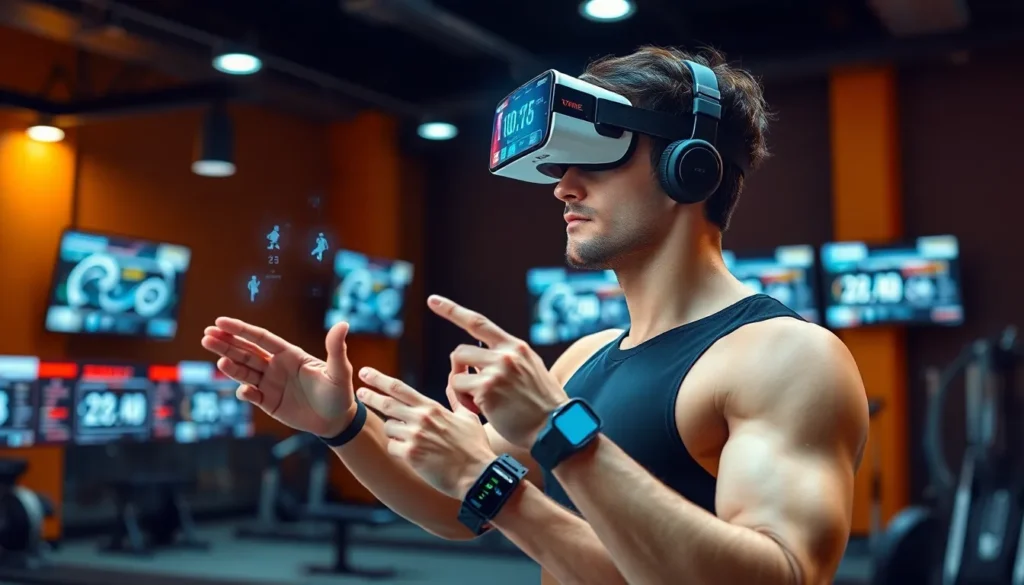In the fast-paced world of sports, technology is the secret sauce that’s transforming the game. From smart wearables that track every heartbeat to virtual reality training sessions that make athletes feel like superheroes, innovation is the name of the game. Imagine a world where players can analyze their performance in real-time while coaches shout motivational quotes from a hologram—yes, it’s as wild as it sounds!
New Technology In Sports
New technology reshapes the landscape of sports, enhancing performance and providing valuable insights. Innovations are ushering in a new era of training and competition.
Importance of Technology in Sports
Technology plays a critical role in optimizing athlete performance. Real-time data collection enables coaches to adjust training regimens based on specific metrics. Wearable devices track health parameters, reduce injury risk, and enhance recovery protocols. Analytics tools foster better decision-making during competitions by analyzing opponent strategies. Enhanced fan engagement driven by technology improves the overall sports experience. Visualization techniques using virtual reality allow athletes to practice in immersive environments and refine skills.
Current Trends in Sports Technology
Emerging trends highlight significant developments in sports technology. Smart equipment, like sensors in balls and bats, provide data on technique and performance. Augmented reality applications educate fans and coaches through interactive experiences. Platforms integrating artificial intelligence streamline player scouting and recruitment processes. Drones capture dynamic angles of games, offering unique perspectives for analysis. Gamification in training programs helps to motivate athletes by introducing competitive elements. Data analytics software continues to evolve, enabling deeper insights into gameplay, fitness levels, and injury prevention.
Wearable Technology

Wearable technology significantly enhances athletic performance by providing real-time insights into health metrics and training data. These innovations empower athletes to optimize their workouts and recovery strategies.
Fitness Trackers and Smartwatches
Fitness trackers and smartwatches play pivotal roles in monitoring daily activities. These devices collect data such as steps taken, heart rate fluctuations, and calories burned. Users access performance metrics through intuitive interfaces that translate complex data into actionable insights. Popular brands, including Fitbit and Apple Watch, illustrate the growing trend of integrating fitness tracking with everyday technology. Numerous studies indicate that athletes who utilize these devices improve their overall fitness levels and maintain motivation throughout their training cycles.
Performance Monitoring Devices
Performance monitoring devices offer advanced analytics for serious athletes. Many products include heart rate monitors, GPS trackers, and smart clothing that assess biomechanical data. Coaches and trainers utilize these insights to fine-tune training regimens. Analysis from these devices assists in identifying individual strengths and weaknesses during competitions. Increased accuracy in gauging exertion levels and recovery needs enhances athletes’ preparation strategies. Notable examples include the WHOOP Strap, designed for optimizing recovery and performance through personalized data.
Virtual Reality and Augmented Reality
Virtual reality (VR) and augmented reality (AR) transform the sports landscape. These technologies enhance training and interaction, creating more immersive experiences.
Training Applications
VR allows athletes to simulate game scenarios, providing a safe environment for skill development. Athletes gain experience by practicing specific plays repeatedly. AR overlays performance metrics during training sessions, offering real-time feedback that helps athletes adjust their techniques. Coaches analyze these metrics to tailor personalized training plans. For example, programs like STRIVR immerse football players in game situations, improving decision-making skills without physical risk.
Fan Engagement
AR engages fans like never before, offering interactive experiences during games. Fans can use AR apps to view player stats, replays, and game highlights through their devices. VR offers virtual stadium experiences, enabling fans to attend games from anywhere in the world. This technology fosters deeper connections with teams and enhances the overall live sports experience. Brands like NextVR and Oculus Sports revolutionize fan interaction, making sports events more accessible and enjoyable.
Data Analytics and Performance Enhancement
Data analytics enhances athlete performance through detailed analysis and insight generation. Coaches utilize data to monitor individual metrics and improve training programs. With the aid of wearable technology, players track their physical conditions, such as heart rates and energy expenditure. Each data point contributes to a comprehensive understanding of an athlete’s performance. This insight allows for targeted adjustments tailored to individual needs, promoting optimal results.
Player Performance Analysis
Player performance analysis relies heavily on data captured by tools like GPS trackers and heart rate monitors. These devices provide critical information on speed, distance, and exertion levels during training sessions and competitions. Utilizing this data enables coaches to identify trends and assess improvements over time. For example, an athlete’s recovery patterns become clearer, helping to prevent injuries and optimize training loads. Each player’s strengths and weaknesses become more evident, fostering personalized training regimens that enhance overall performance.
Game Strategy Optimization
Game strategy optimization leverages analytics to inform tactics and decision-making. Coaches analyze historical data and opponent tendencies to develop effective game plans. Video analysis software supports this process by providing game footage breakdowns. By studying opponent formations or player positioning, teams identify strategic advantages. Integrating live data during matches allows coaches to make real-time adjustments, enhancing adaptability and performance in dynamic situations. Each analytical insight adds clarity to the decision-making process, ultimately leading to improved team outcomes and competitive advantages.
Equipment Innovations
Equipment innovations continue to transform the sports landscape, utilizing advanced materials and cutting-edge design to enhance performance.
Advanced Materials and Design
New materials greatly improve strength and durability in sports equipment. Carbon fiber and graphene, for instance, significantly reduce weight while increasing resilience. Athletes benefit from this technology as it allows for more effective equipment, like lighter racquets and stronger bikes. Manufacturers often incorporate advanced aerodynamics to enhance performance, particularly in sports like cycling and swimming. Additionally, 3D printing technology enables customization of gear, resulting in tailored fits that cater to individual athlete needs. This not only enhances comfort but also optimizes effectiveness during competitions.
Impact on Athlete Performance
Athlete performance experiences a marked enhancement due to these equipment innovations. Real-time performance analysis becomes possible through smart technologies integrated into gear. Sensors embedded in shoes and clothing track metrics like speed and heart rate, providing invaluable insights. Athletes can monitor their physical state continuously, allowing them to adapt training regimens accordingly. Improved feedback systems empower athletes to focus on areas needing enhancement, maximizing their training sessions. Enhanced equipment contributes to fewer injuries, promoting longevity in sports careers while ensuring athletes reach their full potential.
Conclusion
The integration of new technology in sports is undeniably reshaping the industry. Athletes now have access to tools that not only enhance their performance but also promote their overall well-being. With advancements like smart wearables and immersive training experiences, the future of sports looks brighter than ever.
As technology continues to evolve, it will further bridge the gap between athletes and their goals. Coaches will increasingly rely on data analytics to fine-tune strategies and optimize training regimens. The ongoing innovations in equipment and training methods promise to elevate the sports experience for both athletes and fans alike. Embracing these changes will be essential for anyone looking to stay competitive in this dynamic landscape.

